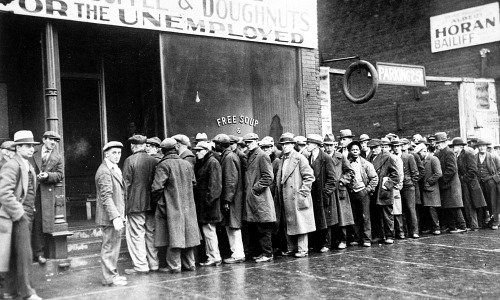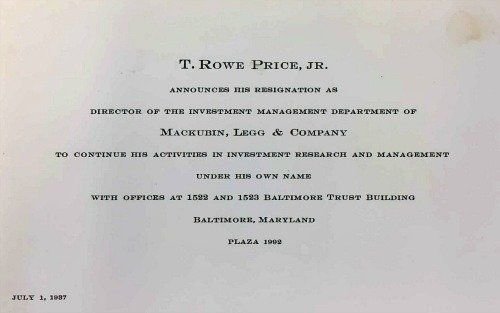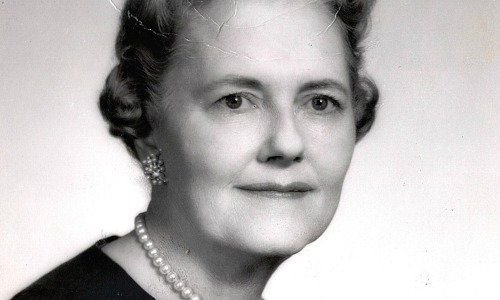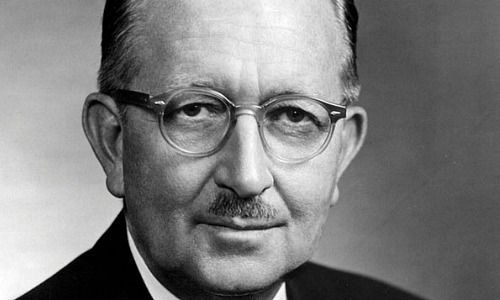The asset management firm T. Rowe Price has exclusively opened its extensive archive for finews.com readers. By roaming through historical documents, a new view of the story of asset management can be discovered.
The papers also tell the fascinating story of T. Rowe Price itself, since its founding in 1937. While beginning with the Great Depression, this series will take the readers on a journey through time and narrate the development of asset management in a chronological manner. Article by article, it will move to the 1950s, 1960s, 1970s, 1980s, 1990s and will finally take a look at the present situation of this industry.
It was the year 1929. On October 29 of this year – known as «Black Tuesday» – the stock market in the U.S. crashed. This event produced a domino effect around the world with the GDP falling by an estimated 15 percent between 1929 and 1932.
It took the economies of some countries until the beginning of the Second World War to recover. It hit poor and rich countries such as the U.S. equally hard: personal income, prices, taxes, and profits dropped while unemployment in the US rose to almost 25 percent.
People Were Suspicious
As a result, people were suspicious of anything that had to do with finances. When they had money, they were reluctant to let it go. The idea of making an investment, especially in stocks, was not appealing to most.

(The Great depression: men outside a soup kitchen, source: Shutterstock)
In 1937/38 the U.S. economy experienced a brief recession, but the following years were characterized by growth, as the United States became a leading motor in wartime production. Yet during this difficult time – in 1937 – a firm was founded by a man named Thomas Rowe Price Jr. which would solely focus on portfolio management on a fee basis. Price called his company like himself: T. Rowe Price. Representatives of other corporations in the industry and even individual asset managers were amused by Mr. Price’s new idea.

(Thomas Price founded his own firm in 1937, source: T. Rowe Price archive)
Heterogenic Industry With Little Regulation
Price had worked as manager of the investment management department at the Baltimore based brokerage house of Mackubin, Legg before he decided to do his own thing. Besides Mackubin, Legg, firms such as Alex Brown and offices of Merrill Lynch dealt with customers assets at that time. Exclusive asset managers, as we know them today, did not yet exist. Generally, it was a wildly mixed industry, with banks, brokers, and individuals consulting customers regarding the best way of managing their assets.
Until SEC regulations were passed in 1940, financial businesses could operate in a legal grey area without having to disclose conflicts or bad practices. Yet, after 1940, the industry experienced a big shift towards a more controlled way of asset management which was obviously a beneficial factor for the customers.
The First Associate
Three years prior, however, when Mr. Price already knew that he wanted to pursue his own philosophy, without any exception. Soon, Mr. Price employed Marie Walper, who had also resigned from Mckubin, Legg. Walper would later become treasurer of the corporation.

(Marie Walper was the first associate of Thomas Rowe Price, source: TRP archive)
Price believed «that there was an inherent possibility of a conflict of interest where the same firm both advised clients and handled their brokerage» it states in a Memo, courtesy of the archives of T. Rowe Price. «Generally, Mr. Price did not like the way customers were treated in the industry», explains Emily Davidson, archivist and Brand Asset Specialist at T. Rowe Price.
Theory of Growth Stock
Mr. Price, therefore, developed his own guidelines which focused on principles of ethics, transparency for and a good relationship with the customer, as well as and long-term profit, instead of «quick money» and fast results. The latter were criteria most of the rest of the industry aimed for. T. Rowe Price’s principles were «new and untested», states the Memo.
While other corporations maintained classical forms of investment consulting, T. Rowe Price also developed his theory of «growth stock.» According to Emily Davidson, Mr. Price is considered the pioneer of this theory. And he also became widely known for it.
Keeping a Distance to Wall Street
Price started his firm in Baltimore. Then, the city between New York City and Washington D.C. was still a thriving financial hub. One of the leading banks in the financial district was the Bank of Baltimore, which would later become the National Bank of Baltimore.
After several years passed by, the population significantly decreased and most asset managers moved to New York to be close to Wall Street. Price, however, decided to keep his distance and still stay in Baltimore. «Mr. Price had a deep suspicion of Wall Street and brokers. He thought that if they really had something worth saying or selling, they’d come down on the train,» states a former analyst hired in 1961.
- How did the asset management industry progress in the following two decades, the so-called booming years of the 1950s and 1960s? This question will be answered in part two of this historical journey through time. Stay tuned!
This material is being furnished for general informational purposes only. The material does not constitute or undertake to give advice of any nature, including fiduciary investment advice, and prospective investors are recommended to seek independent legal, financial and tax advice before making any investment decision. T. Rowe Price group of companies including T. Rowe Price Associates, Inc. and/or its affiliates receive revenue from T. Rowe Price investment products and services. Past performance is not a reliable indicator of future performance. The value of an investment and any income from it can go down as well as up. Investors may get back less than the amount invested. The material does not constitute a distribution, an offer, an invitation, a personal or general recommendation or solicitation to sell or buy any securities in any jurisdiction or to conduct any particular investment activity. The material has not been reviewed by any regulatory authority in any jurisdiction. Information and opinions presented have been obtained or derived from sources believed to be reliable and current; however, we cannot guarantee the sources' accuracy or completeness. There is no guarantee that any forecasts made will come to pass. The views contained herein are as of the date noted on the material and are subject to change without notice; these views may differ from those of other T. Rowe Price group companies and/or associates. Under no circumstances should the material, in whole or in part, be copied or redistributed without consent from T. Rowe Price. The material is not intended for use by persons in jurisdictions which prohibit or restrict the distribution of the material and in certain countries the material is provided upon specific request. It is not intended for distribution to retail investors in any jurisdiction. EEA ex-UK – Unless indicated otherwise this material is issued and approved by T. Rowe Price (Luxembourg) Management S.à r.l. 35 Boulevard du Prince Henri L-1724 Luxembourg which is authorized and regulated by the Luxembourg Commission de Surveillance du Secteur Financier. For Professional Clients only. Switzerland -Issued in Switzerland by T. Rowe Price (Switzerland) GmbH, Talstrasse 65, 6th Floor, 8001 Zurich, Switzerland. For Qualified Investors only. UK - This material is issued and approved by T. Rowe Price International Ltd, 60 Queen Victoria Street, London, EC4N 4TZ which is authorized and regulated by the UK Financial Conduct Authority. For Professional Clients only. © 2019 T Rowe Price. All rights reserved. T. ROWE PRICE, INVEST WITH CONFIDENCE and the Bighorn Sheep design are, collectively and/or apart, trademarks or registered trademarks of T. Rowe Price Group, Inc.



































